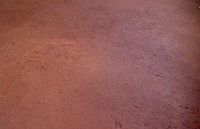- Earthen floor
-
An earthen floor, also called an adobe floor, is a floor made of dirt, raw earth, or other unworked ground materials. It is usually constructed, in modern times, with a mixture of sand, finely chopped straw and clay, mixed to a thickened consistency and spread with a trowel on a sub-surface such as concrete. Once dry, it is then usually saturated with several treatments of a drying oil.
Contents
Benefits
- Variety of colors, textures, and materials
- Can be installed over nearly any subflooring
- Integrates well with in-floor radiant heat tubing
- One of the cheapest flooring methods, green or otherwise.
History
Earthen floors were predominant in most houses until the mid 14th century in Europe, and persist to this day in many parts of the world.[1] In medieval times, almost all peasant housing had earthen floors, usually of hardpacked dirt topped off with a thin layer of straw for warmth and comfort. Soil in the southwestern parts of the US contain nearly a perfectly mixed ratio of adobe.
In China, most cottages and smaller houses also had earthen floors, made of rammed earth and sealed with raw linseed.[2]
Earthen floors were discovered in ancient Greece,[3] and in many other early developing civilizations.
Construction
In modern times, most earthen floors are often laid over the top of a subfloor of tamped gravel and then a mixture of clay, sand and fiber are mixed and leveled onto the tamped subfloor. These layers can be 1/8 to 1/4 of an inch thick. The thinner layers will dry faster but require a better subfloor for strength or more layers. Earthen floors can be laid over the top of previously installed wood floors but weight can become an issue.
Finishing
A drying oil like Linseed oil is usually used to seal the floor and protect it from wear and tear. A final coat of perilla oil and a wax sealing finish are also used on high traffic flooring areas.
References
- ^ Gies, Frances & Gies, Joseph, Life in a Medieval Village
- ^ Mitsu,Ahn , Developments in History: China
- ^ McAllister, Marian Holland; Bradley A. Ault (2005). The Excavations at Ancient Halieis: The Houses: The Organization and Use of Domestic Space. Indiana University Press. p. 103. ISBN 0253347106. http://books.google.com/books?id=nGwIb2uEIbIC&pg=PA103&dq=Earthen+floor&ei=QQ_-SJm7O4uWyATm3cWiDw&client=firefox-a.
External links
- http://www.dancingrabbit.org/newsletter/Newsletter0701-floors.php (6 parts sand, 2 parts clay, 1 part finely chopped straw)
- http://www.housealive.org/newsletter-archive/earthen-floors.html (5 in road base + 1 in [70% sand, 30% clay and about 10% straw])
- Gelles, David, "Down and Dirty", The New York Times, February 8, 2007
- http://www.LanderLand.com (step by step how to)
Categories:- Floors
Wikimedia Foundation. 2010.

